A pair of dark eyes and a golden-colored snout with a pink nose tip peeks at me from the middle of the branches and leaves. Its black fur is harder to spot from the lush tree, but when I see the shiny, golden, crescent-shaped fur collar around its neck, I will perceive the tiniest bear in the world – a Bornean Sun Bear – is the one who’s peeking on me.
Every bear individual has a unique fur collar like us humans have our fingerprints, and that’s how their keepers will know who’s who. We are visiting at the Bornean Sun Bear Conservation Center in Sabah, Malaysian Borneo, where there are 44 rescued ex-captive or orphaned sun bears living in the center’s area today.
They look incredibly cute and cuddly, especially because they have a tendency to hang their long, pink, and thin tongue out of their mouth most of the time. Sun bears are also known as a “honey bear” because of their particular appetite for honey or a “dog bear” because of their small size.
Sun Bears Are Under Many, Serious Threats
The killing of sun bears is strictly prohibited under all wildlife protection laws in Southeast Asia. However, little enforcement of such legislation occur, and conservation priorities vary by country. The Bornean Sun Bears are listed as “vulnerable” by the IUCN, but they are still under a severe and continuous threat.
Despite the strict sanctions against their capture, sun bears are often illegally held as pets. Many of the sun bears living in the BSBCC (Bornean Sun Bear Conservation Center) in Sepilok are confiscated from private persons. Individuals who break the Malaysian law by imprisoning a sun bear can get a fine of up to RMY 50,000 ($15,000) and five years in prison.
More public education against capturing sun bears could do magic to this problem and this is one of the things the BSBCC is trying to achieve, but they have a long road ahead with the limited budgets and most of their funds are coming from donations.
The Bornean Sun Bears are also often victims of poaching; parts of their gallbladders are still highly prized in traditional Chinese medicine. These little and shy bears can also get attacked by other animals, like big cats.
But the worst threat to their survival is the deforestation. The Bornean Sun Bears are vitally dependent on the forest, but much of Sabah’s rainforest has been cleared for palm plantations. And even thought the government took action in 2013 to protect large tracts of land as a last-ditch effort to save at least some of Southeast Asia’s few primary rainforests, the clearing still continues. Also, many conservation groups fear that these protected areas are far from enough.
When driving in Sabah you will see a palm tree row after another, as far as the eye can see, and you can vividly imagine what that has meant for all the different species whose living habitats have disappeared with the deforestation. The fragments of land that has been left untouched by the palm oil industry or the logging for hardwood are way too small to provide a suitable habitat for most of the species – the Bornean Sun Bears being one of them.
The Bornean Sun Bear Conservation Center – A Sun Bear Haven
The Bornean Sun Bear Conservation Center (BSBCC) was opened to the public in 2014 after a long-term project of its founder, Dr. Wong Siew Te, a wildlife biologist, a tropical forest ecologist and a sun bear expert. With his tireless desire and effort, he raised funds and built the first bear house from scratch with a budget of just $4000. Fortunately, BSBCC’s partners; Sabah Forestry Department, Sabah Wildlife Department, and Land Empowerment Animals People (LEAP) have significantly helped them over the years to achieve what is standing today.
When we were visiting in Sepilok, I was more excited to meet the sun bears than the orangutangs, to tell you the truth. The bear’s faces had some distinctive features, and their presence was somehow sympathetic. I loved watching them foraging on the forest floor, as well as trying to spot them from the canopy.
These guys were not the easiest to get photographs from, though. But I enjoyed the challenge and still managed to get some decent shots from these gorgeous fellas. The center has two viewing platforms from which you can observe the sun bears while they are roaming the forest around.
However, raising funds for this relatively unknown species is not easy. The Bornean Sun Bears are not familiar to the vast masses, and the attention of the big NGOs and their campaigns often go to the more flashy fauna, like the orangutans, elephants, or rhinos. So, every cent counts and no effort is too small to help this teddy bear-like and cute creatures on their way through the center’s rehabilitation and reintroduction programs back to the wild.
Luckily the BSBCC is in Sepilok next to the Sepilok Orangutan Rehabilitation Center. So, when visitors come to see the famous orangutans, they can also visit The Bornean Sun Bear Conservation Center and get to know these lovely, small bears who hang in the tree branches, roam the grounds in searching for honey combs, and are as curious about you as you are about them.
Critical Work and Research at the BSBCC Center in Sepilok, Borneo
At the Bornean Sun Bear Conservation Center in Sepilok-Kabili Forest Reserve, the researchers and staff are reintroducing the bears back to their natural habitat, and they have the largest forest enclosures of any sun bear center. All the bears looked to be in excellent condition and above all, they seemed euphoric roaming around in their forest.
The BSBCC’s goal is to eventually release the bears back into the wild after they’ve learned some vital skills they will need to survive, like tree climbing, nest building, self-defense, and foraging.
Unfortunately, some bears are too traumatized to be released back into the wild. But the Bornean Sun Bear Conservation Center will provide a permanent home for these bears, and they can live happily for the rest of their lives in the center’s care.
Increasing the knowledge of sun bears is also important; they are the least researched bear species in the world. Their low numbers, difficult terrains, and shy nature has made the research much more challenging. So, the bears at the BSBCC also provide much-needed opportunities to researchers to study these little bears.
The Bornean Sun Bear Conservation Center also does the essential work of educating the people about the animal welfare and conservation, and promoting awareness of sun bears where it’s needed the most – locally. In collaboration with other NGOs they have outreach programs for schools, and also for plantations where they go to talk with the workers.
How You Can Help to Protect the Bornean Sun Bears?
The Bornean Sun Bears have critical roles in the well-being of the forest environment, and they always belong to the wild! You can help the Bornean Sun Bear Conservation Center’s crucial work in many ways. You can adopt a sun bear on their pages where you can pick your favorite bear to sponsor, or you can make a smaller donation and buy, for example, a pot of honey, a hammock, or medical supplies for the bears. You can also participate in their volunteer programs if you want to make a personal difference and have an experience of a lifetime.
And if you happen to visit Borneo and the Sandakan/Sepilok area, be sure not to miss a visit to the Bornean Sun Bear Conservation Center! Spend a memorable afternoon with these shy, but adorable, little bears and please leave a donation. Nothing is too little an effort, and everything counts. The Bornean Sun Bears deserve more attention, and they sure left a heart-shaped mark in my soul!
PIN THIS STORY & HELP TO SPREAD THE WORD!
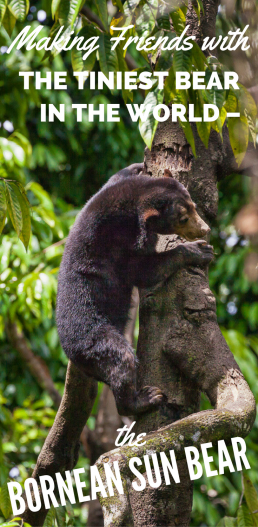
You May Also Like to Read:
Kinabatangan River Cruise in Malaysian Borneo: Everything You Need to Know
Take a boat ride to the Kinabatangan River in Borneo and keep an eye out for the Bornean Pygmy Elephants and Proboscis monkeys.
2-Week Borneo Itinerary: Best Route for Orangutans, Beaches, Jungles, and Colonial Cities
A full two-week adventure itinerary in the Malaysian Borneo. Orangutans, pygmy elephants, proboscis monkeys, primary rainforests and supreme snorkeling on a paradise island.
Adopt an Orphaned Elephant From The David Sheldrick Wildlife Trust
Give a gift of life - adopt an elephant! The orphan-elephant program developed by The David Sheldrick Wildlife Trust is the most successful in the world. We visited their orphanage in Nairobi and decided to foster a baby elephant.
How to Save the Declining Lion Population of East Africa
The lion population of Tanzania has dropped 60%. What in earth is happening, and how could we save the iconic lions of East Africa?
Tracking Rhinos on Foot in Uganda
Would you dare to track down rhinos on foot? We followed a ranger to the thick Ugandan bush to see our first white rhinos from zero distance.
Visiting a Wildlife Rescue Center in Costa Rica
Visiting a wildlife rescue center when you're in Costa Rica is a must-do. But don't forget to choose responsibly the place you visit. There is a good selection of non-profit places where the welfare of animals comes first.


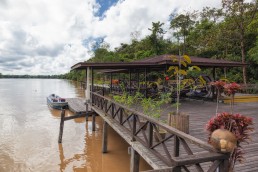
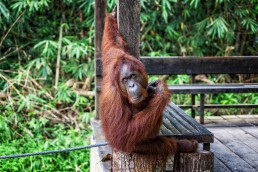
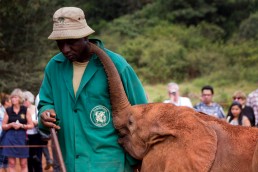
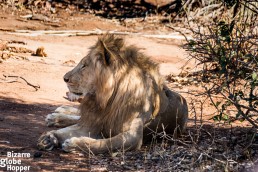
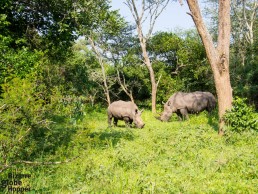
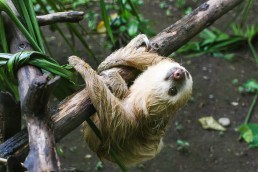
For many years I’ve been a supporter of Animals Asia who, among other things, rescue Moon Bears from bile farms but I knew little about Sun Bears. It really is heartbreaking that so many wicked individuals are happy to destroy the rainforests. Heading over to the conservation group’s website know. I’ve photographed Grizzly Bears and Black Bears in the wild. Would love to see Sun Bears too one day.
So glad to know that you liked to read about the sun bears! Very little is known about this tiniest bear in the world, and they will truly need all the support they can get. If you ever have the chance, go visit the BSBCC in Sabah! 🙂 They tend to get overshadowed by the orangutans, but hopefully the sun bears will also have a bunch of new visitors to their new, beautiful rescue center!
What an insightful post. The bears are beyond adorable. It’s amazing that they have unique collars . I just hope as humans we take every measure to protect them and cherish them. Thanks for sharing.
Vrithi Pushkar
Thanks, Vrithi! Those bears truly are adorable and fascinating! We really hope that their conservation efforts would raise more attention and that they could be efficiently protected. Thanks for stopping by and if you ever go to Sepilok, don’t miss a visit to the sun bears. 🙂